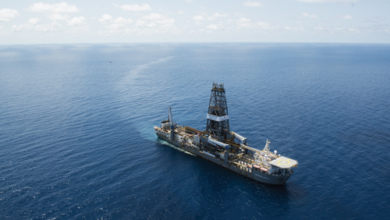By Mike Killalea, Editor & Publisher
… but I’ll be wrong like everyone else. Prediction is difficult, especially if it’s about oil futures (apologies to Niels Bohr).
In 1998 – not the best year for drilling by a long shot – the Energy Information Administration soberly predicted a nearly linear decline in US production through 2020, ramping down from 6.5 million bbl/day in 1996 to an anemic 4.9 million bbl/day.
Similarly, for decades, actual US oil production dutifully tracked the bell-shaped decline curve postulated by Hubbert in 1956. But reality had other ideas. Beginning around 1991, the two curves diverged, with actual production swinging sharply north in the mid-2000s and never looking back.
Of course, it was the North American shale revolution that upended these and other learned forecasts. It was a major step change with incredible impact. Instead of production and reserves shrinking into oblivion, they grew exponentially for both oil and natural gas. Plus, imports were slashed by nearly a third.
We have confounded the pundits time and again. Through the 1990s, we were tagged a “sunset industry,” headed inexorably toward the exit, our products to be replaced by… well, that was never quite clear.
Gallows humor
Industry’s latest meme, born of the downturn’s gallows humor, is amusement at the demonstrably and laughably incorrect predictions of yesteryear. History offers a plethora of hilarious wrong-way forecasts. (See the entertaining link below.) But can we do better? Would we have seen the shale revolution coming? Will we see the next step change coming?
Oilfield truism
It’s an article of faith that downturns spur innovation. The correlation is less than crystal clear, though. The top drive was introduced in 1982, the peak of the previous boom, while the PDC bit came on the market in 1972, the nadir of the preceding downturn. I think that we tie innovation to downturns simply because we endure so many downturns.
In any event, the drumbeat of improved practices and technology steadily continues. At the peak of North American shale drilling, we used half the drilling rigs that we did 30 years before.
In 1982, 4,000 rigs were making hole. Thanks to advances in rig design, horizontal drilling, multistage hydraulic fracturing, walking rigs, improved bits, fluids and solids control, among other advances, we barely deployed 2,000 rigs into the shale revolution.
As these efficiencies improve further in the years ahead, will we need even 2,000 rigs in the future?
The game is afoot
Industry is wasting no time. Several articles herein present creative means to drill faster, safer and better.
• In “Drilling to the Limit,” a new group of more than 20 operators addresses what it sees as well-construction technical gaps.
• Petrobras continues its drive to mainstream MPD, discussing herein converting 15 rigs to MPD ready by year-end.
• “Avoiding the Money Pit” examines cost-effective tactics to develop drilling facilities.
These are only three examples of great ideas set forth in this issue. I hope that you will find inspiration to carry you through this very rough patch.
Survival is an interesting, if frantic, dance. It’s what we bring to the post-survival era that will mark our success or failure.





